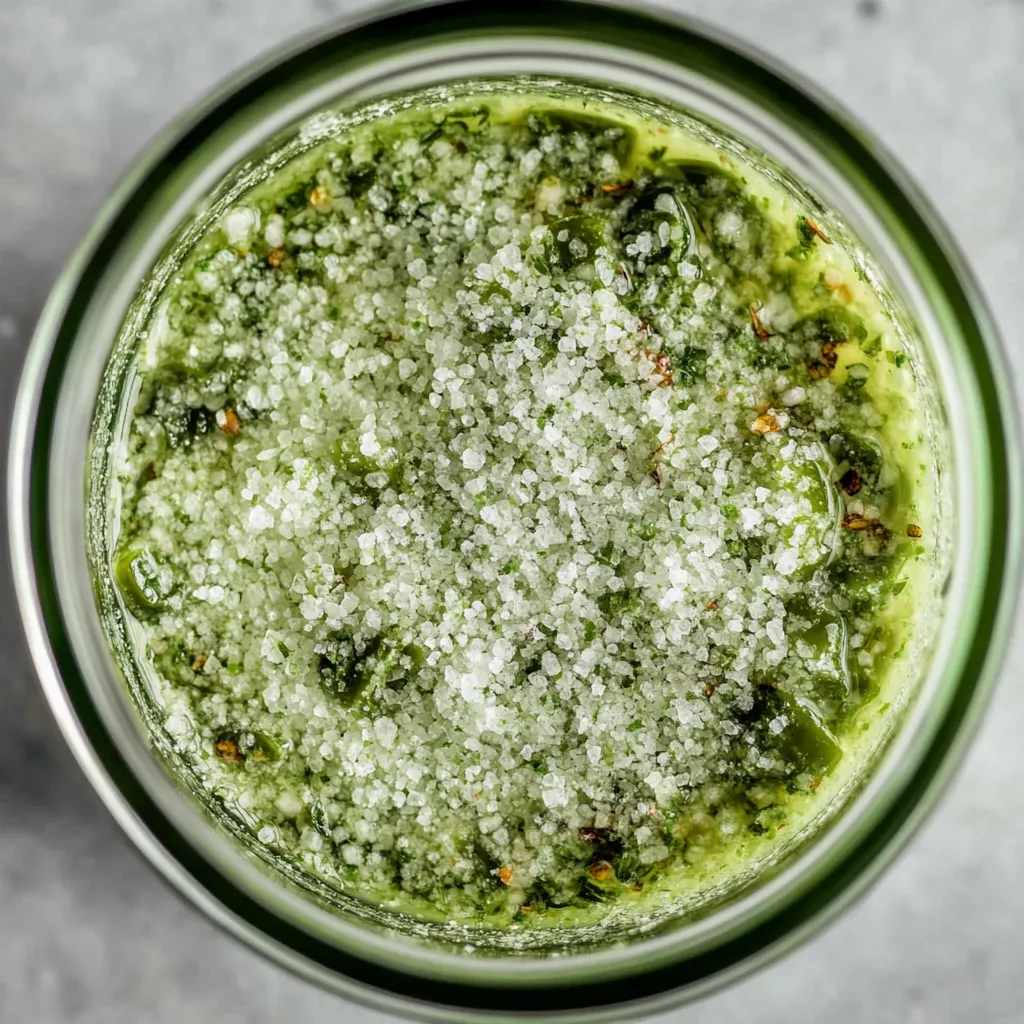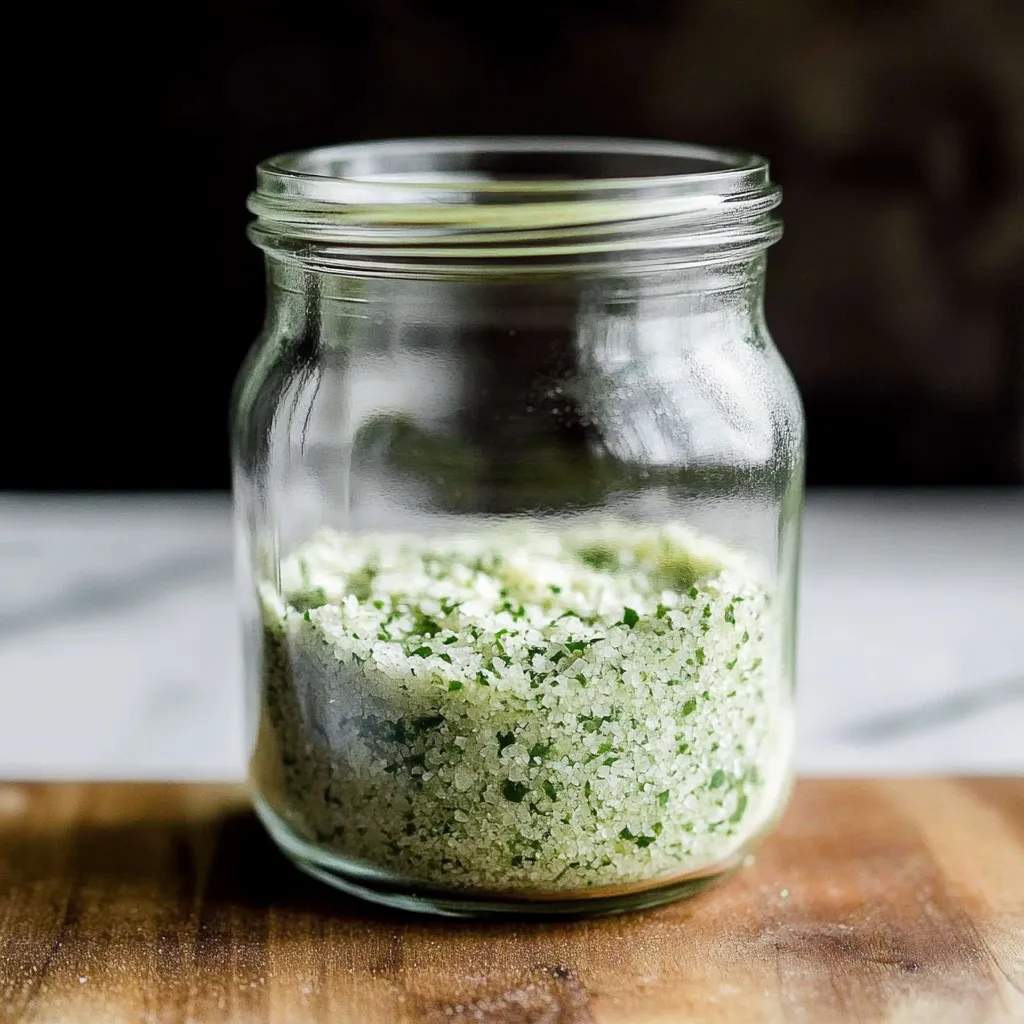 Pin it
Pin it
This incredibly flavorful homemade jalapeño salt transforms ordinary seasoning into a versatile, spicy condiment that elevates everything it touches. Made with just two simple ingredients—fresh jalapeños and coarse kosher salt—this aromatic blend delivers the perfect balance of heat and saltiness that enhances meats, vegetables, popcorn, and even cocktail rims. The secret lies in properly dehydrating the peppers until they're perfectly crisp, then grinding them with salt to create a vibrant, flavorful seasoning you'll want to sprinkle on absolutely everything.
I made this last summer when my garden was overflowing with jalapeños, and it's become my secret weapon in the kitchen! My brother-in-law, who's quite the grilling enthusiast, said it's the best seasoning he's ever used on steak. Even my spice-sensitive mother asks me to bring a jar whenever I visit—she loves it on her baked potatoes and scrambled eggs.
Ingredients
- Fresh jalapeño peppers: The star of this recipe, providing both heat and distinctive flavor. Fresh peppers are essential for the best taste and proper dehydration—never substitute pickled jalapeños.
- Coarse kosher salt: Creates the perfect texture and provides the essential saltiness that balances the heat. The coarse texture is important for proper grinding and final consistency.
Instructions
- Step 1:
- Prepare for safety by putting on disposable gloves before handling any peppers—this is absolutely non-negotiable when working with 3 pounds of jalapeños. The capsaicin oils will absorb into your skin and cause burning for days if you skip this step. Set up your workspace in a well-ventilated area, preferably near an open window or outside if possible, as the cutting process will release strong fumes.
- Step 2:
- Prepare the jalapeños carefully by washing them thoroughly under cool running water and patting them completely dry with paper towels. Using a sharp knife, cut each jalapeño lengthwise into quarters, removing the stems as you go. For milder salt, remove all seeds and white membranes (the hottest parts). For medium heat, remove about half the seeds. For maximum heat, leave all seeds and membranes intact. Work systematically through all 3 pounds, placing the prepared pieces on your dehydrator trays as you go.
- Step 3:
- Set up your dehydrator outdoors if at all possible—the dehydrating process releases incredibly strong, potentially irritating fumes that can make your house uninhabitable and may cause respiratory irritation or eye burning. Arrange the jalapeño pieces on dehydrator trays in a single layer, ensuring pieces don't touch or overlap. Set your dehydrator to 145°F and begin the drying process, which will take approximately 12-15 hours depending on the thickness of your pepper pieces and humidity levels.
- Step 4:
- Monitor the dehydration process by checking the peppers after about 10 hours, then every hour thereafter. The jalapeños are properly dehydrated when they are completely brittle and snap easily when broken—they should have no flexibility or moisture remaining. Any pieces that still feel soft or pliable need more drying time. Properly dehydrated peppers will have shrunk significantly and feel lightweight and crispy.
- Step 5:
- Cool before grinding by allowing the dehydrated jalapeños to cool completely to room temperature before proceeding. This prevents condensation from forming in your grinder, which could affect the final texture and storage life of your salt. Once cooled, the peppers can be stored in airtight containers for several days before grinding if needed.
- Step 6:
- Grind to perfection by combining the completely cooled, dehydrated jalapeños with 1 cup of coarse kosher salt in a high-powered blender or food processor. Pulse initially to break up the peppers, then blend continuously until the mixture reaches a fine, uniform powder consistency. The salt helps break down the peppers while absorbing their oils and flavors. The final product should be a vibrant, evenly colored mixture with no large pepper pieces visible.
- Step 7:
- Store properly by transferring the finished jalapeño salt to airtight containers immediately after grinding. Glass jars with tight-fitting lids work best for maintaining potency and preventing moisture absorption. Label with the date and heat level for future reference. Store in a cool, dry place away from direct sunlight where the salt will maintain its flavor and potency for up to one year.
 Pin it
Pin it
I learned the hard way about the importance of gloves and ventilation when I first made this recipe! After spending a miserable night with burning hands and a house that smelled overwhelmingly of peppers, I now always work outside with proper protection. The result is so worth the extra precautions—this salt has become my signature seasoning that friends and family specifically request.
Selecting and Preparing Jalapeños
The quality of your jalapeños significantly impacts the final product, so choose peppers carefully. Look for fresh, firm jalapeños with smooth, unblemished skin and bright green color. Avoid peppers that are soft, wrinkled, or show dark spots, as these won't dehydrate properly and may introduce off-flavors. The size and heat level of jalapeños can vary considerably—smaller, more mature peppers with stress lines (small cracks in the skin) tend to be hotter, while larger, smoother peppers are typically milder. If you're growing your own, harvest jalapeños when they're fully sized but still green for the classic flavor. Red jalapeños (fully ripe) can also be used for a slightly sweeter, more complex flavor profile. When preparing, cutting the peppers into uniform sizes ensures even dehydration—quarters work well for most home dehydrators.
Dehydration Techniques and Safety
Proper dehydration is crucial for both safety and flavor development. The 145°F temperature is optimal for preserving flavor while ensuring complete moisture removal. Lower temperatures take much longer and may not remove all moisture, leading to spoilage, while higher temperatures can cook the peppers and alter their flavor. The outdoor dehydration recommendation isn't just for comfort—the fumes can trigger respiratory issues in sensitive individuals and the smell can linger in your house for days. If you must dehydrate indoors, ensure excellent ventilation, close bedroom doors, and consider running air purifiers. The dehydration process is complete when peppers snap cleanly and show no bend or flexibility. Properly dehydrated peppers will have lost about 90% of their original weight and will rattle when shaken. Don't rush this process—underdried peppers will create inferior salt and may spoil during storage.
Grinding and Texture Considerations
The grinding process requires attention to achieve the perfect texture. A high-powered blender or food processor works best—coffee grinders can work for small batches but may not handle the volume efficiently. Start with short pulses to break up the large pieces, then blend continuously, stopping occasionally to scrape down the sides. The coarse salt acts as an abrasive that helps break down the peppers while absorbing their oils and flavors. The final texture should be fine and uniform—too coarse and the salt won't distribute evenly, too fine and it may clump. If the mixture seems to clump during grinding, the peppers may not have been completely dry or there may be too much humidity in the air. In humid conditions, consider adding a few grains of rice to absorb excess moisture during grinding, then sift them out before storing.
I discovered this recipe during my first serious gardening year when I planted way too many jalapeño plants and was desperate to find ways to preserve the overwhelming harvest. What started as a practical preservation method has become one of my most treasured kitchen staples. The process taught me patience and respect for the power of peppers, but the reward—having this incredible seasoning available year-round—makes every precaution worthwhile. I now start each summer by making multiple batches in different heat levels, and I've never met anyone who doesn't want to take home a jar after trying it. There's something deeply satisfying about creating such a flavorful, useful condiment from just two simple ingredients, proving that the best seasonings often come from the most straightforward approaches.
Frequently Asked Questions
- → How long does homemade jalapeño salt last?
- Store it in an airtight container and it stays fresh for several months. Keep it in a cool, dry place away from sunlight.
- → Can I make this without a dehydrator?
- Yes, you can use your oven on the lowest setting with the door slightly open. It takes longer but works just as well.
- → Should I remove the seeds for less heat?
- Remove seeds for milder salt, keep them for maximum spice. The choice depends on how much heat you can handle.
- → Why do I need to wear gloves?
- Jalapeño oils stick to your skin and burn. Gloves protect your hands and prevent accidentally touching your eyes later.
- → What can I use jalapeño salt on?
- Try it on grilled vegetables, baked potatoes, roasted meats, popcorn, or anything that needs a spicy kick.
